
“The faith is strong on this one.”
The elusive Olympic gold medal was not the only one that 30-year-old weightlifter Hidilyn Diaz was wearing in her victory photos.
The Zamboangueña made history on Monday when she won in the women’s 55-kilogram category for weightlifting at the Tokyo Olympics 2020 and took home the country’s first-ever gold medal in the Olympics.
Her achievement brings the Philippines’ all-time Olympic medal tally to one gold, three silvers and seven bronzes.
When pictures of her wearing the medal were reported on news outlets, some Filipinos noticed a silver pendant hanging on her neck.
It was the Miraculous Medal of Our Lady of Graces, one of the most recognized and popular devotional items associated with miracles and conversions.
TV host and producer Daphne Osena Paez noted that Diaz’s first original Instagram Story after the win was a picture of her holding the silver pendant:
“Who among us didn’t shed a tear with her when the (Philippine national anthem) played, her dignified salute, the moment she knew she won when she lifted… and the first thing she said and did was to praise God…”
“Her first Instagram story… she’s holding up her Gold Medal and the Miraculous Medal of Our Lady of Graces. The faith is strong on this one. Mabuhay ka #HidilynDiaz.”
Catholic community Dominus Est also took note of how Diaz “was quick to attribute her win to the Lord” through a video:
“But tonight’s gold was even more meaningful as Hidilyn was quick to attribute her win to the Lord, pointing up (watch video to the end) and reaching for the Miraculous Medal of Our Lady on her neck.”
“As we celebrate 500 Years of Christianity, it is touching to note that the Philippines’ first Olympic gold medalist is Gifted to Give! And as we celebrate 500 Years of the Conversion of St. Ignatius, Hidilyn shows us true Magis—an Olympic Gold for the Philippines, but most of all, for the Greater Glory of God!”
The Minor Basilica and Metropolitan Cathedral of the Immaculate Conception in Manila likewise noticed Hidilyn’s Miraculous Medal and thanked her for “bringing honor to our country.”
The Miraculous Medal Apostolate said that the Olympic medal serves as Diaz’s “testament to her perseverance” while her Miraculous Medal is “a testament to her faith.”
“Truly, when we faithfully approach Him, diligent in prayer and labor, we receive the graces we confidently and fervently ask for. Congratulations, Hidilyn! May Our Lady of the Miraculous Medal continue to intercede for you,” the religious organization said.
Diaz in her initial victorious moments in the Olympics has consistently thanked the Lord, a testament of her religious fervor.
“Thank you, Lord, thank you, Lord,” she was quoted as saying.
The weightlifter also pointed her index finger to the heavens during the medals ceremony and did a Sign of the Cross towards the end.
“Hindi ako makapaniwala na nandoon ‘yung pangalan ko sa Olympic record. So, I’m really thankful. Grabe si God. Grabe si God,” Diaz remarked after her historic win.
Medal’s story
According to the Miraculous Medal Shrine, the medal had its beginnings when St. Catherine Labouré was visited by the Virgin Mary when she was still a novitiate in 1830.
The apparition was described as “standing on a globe, with dazzling rays of light streaming from her outstretched hands.”
“Framing the apparition was an inscription: ‘O Mary, conceived without sin, pray for us who have recourse to thee,'” the website of the Miraculous Medal Shrine notes.
“When Mary spoke to St. Catherine, she said ‘Have a medal struck upon this model. Those who wear it will receive great graces, especially if they wear it around the neck. Those who repeat this prayer with devotion will be, in a special manner, under the protection of the Mother of God. Graces will be abundantly bestowed upon those who have confidence,'” it added.
The first medals were made in 1832. It was eventually distributed with the name “Miraculous Medal.”









